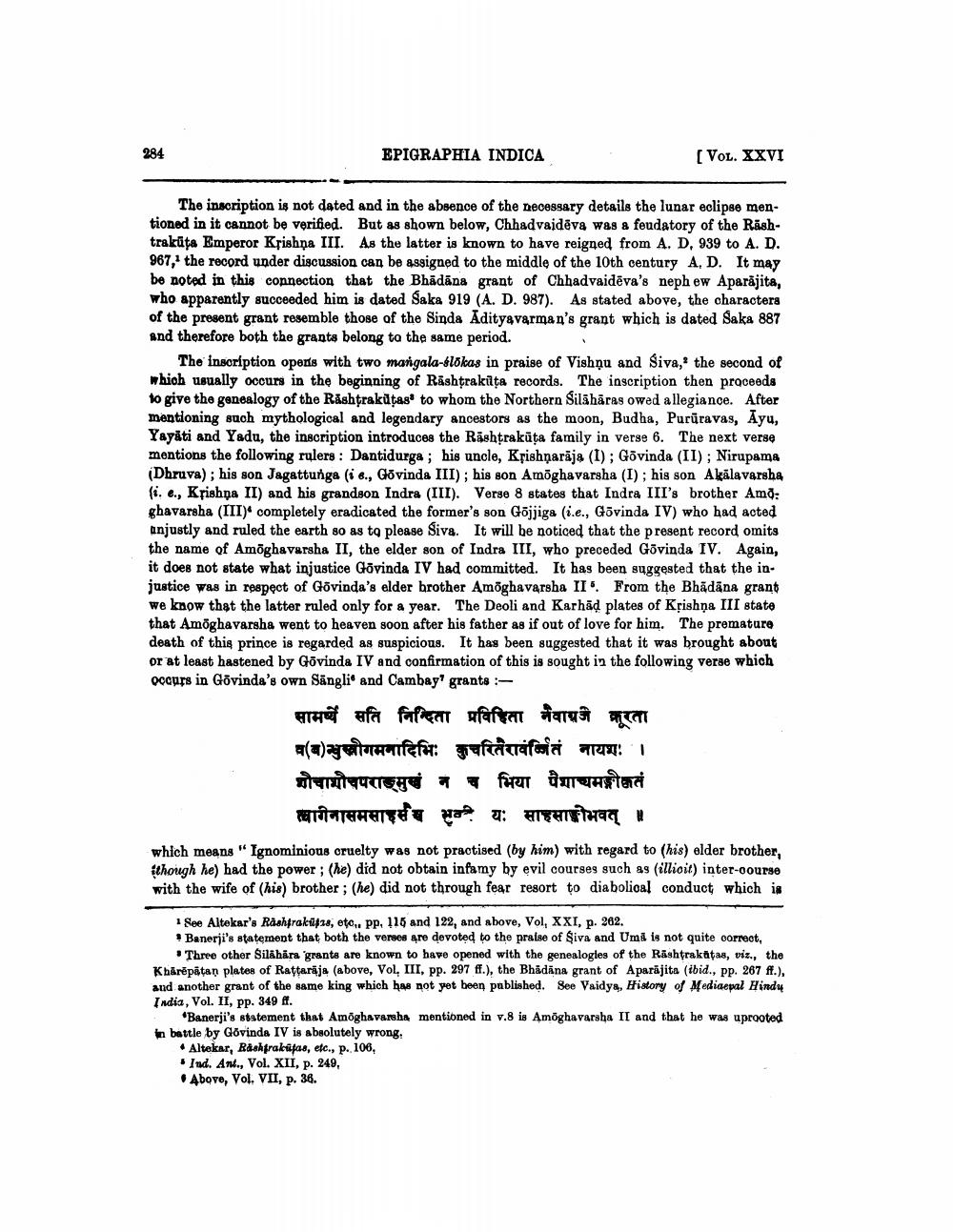________________
284
EPIGRAPHIA INDICA
(VOL. XXVI
The inscription is not dated and in the absence of the necessary details the lunar eclipse mentioned in it cannot be verified. But as shown below, Chhadvaidēva was a feudatory of the Rashtrakūta Emperor Krishna III. As the latter is known to have reigned from A. D, 939 to A. D. 967, the record under discussion can be assigned to the middle of the 10th century AD. It may be noted in this connection that the Bhädāna grant of Chhadvaidēva's nephew Aparajita, who apparently succeeded him is dated Saka 919 (A. D. 987). As stated above, the characters of the present grant resemble those of the Sinda Adityavarman's grant which is dated Saka 887 and therefore both the grants belong to the same period.
The insoription opens with two mangala-flókas in praise of Vishņu and Siva, the second of which usually occurs in the beginning of Răshtrakūta records. The inscription then proceeds to give the genealogy of the Rashtrakūtas to whom the Northern Silāhāras owed allegiance. After mentioning such mythological and legendary ancestors as the moon, Budha, Purūravas, Ayu, Yayati and Yadu, the inscription introduces the Rashtrakūta family in verse 6. The next verse mentions the following rulers : Dantidurga ; his uncle, Krishnarija (1); Govinda (II) ; Nirupama Dhruva); his son Jagattunga (i e., Govinda III); his son Amõghavarsha (I); his son Akālavarsha fi. e., Krishna II) and his grandson Indra (III). Verse 8 states that Indra III's brother Amo: ghavarsha (III) completely eradicated the former's son Göjjiga (i.e., Gövinda IV) who had acted unjustly and ruled the earth so as to please Sive. It will be noticed that the present record omits the name of Amõghavarsha II, the elder son of Indra III, who preceded Govinda IV. Again, it does not state what injustice Govinda IV had committed. It has been suggested that the injustice was in respect of Govinda's elder brother Amõghavarsha II. From the Bhādāna grant we know that the latter ruled only for a year. The Deoli and Karhad plates of Krishna III stato that Amoghavarsha went to heaven soon after his father as if out of love for him. The premature death of this prince is regarded as suspicious. It has been suggested that it was brought about or at least hastened by Govinda IV and confirmation of this is sought in the following verse which occurs in Govinda's own Sängli' and Cambay" grants :
सामर्थे सति निन्दिता प्रविहिता नेवाग्रज क्रूरता व(ब)न्धुलीगमनादिभिः कुचरितरावर्जितं नायशः । शौचायौचपराङ्मुखं न च भिया पैशाच्यमङ्गोकतं
स्वागनासमसाहसच मुवी यः साहसाशीभवत् । which means "Ignominious cruelty was not practised (by him) with regard to (his) elder brother, though he) had the power ; (he) did not obtain infamy by evil courses such as (illioit) inter-oourse with the wife of (his) brother; (he) did not through fear resort to diabolical conduct which is
1 See Altekar's Rashfrak , oto. pp. 116 and 122, and above, Vol. XXI, p. 262. • Banerji's statement that both the verses are devoted to the praise of Siva and Umi is not quite oorrect,
• Three other Silāhāra grants are known to have opened with the genealogies of the Rāshţrakātas, viz., the Kharépátan plates of Rattarāja (above, VoL, III, pp. 297 ff.), the Bhädäna grant of Aparajita (ibid., pp. 267 ff.), and another grant of the same king which has not yet been published. See Vaidya, History of Mediaepal Hindu India, Vol. II, pp. 349 ff.
Banerji's statement that Amöghavarsha mentioned in v.8 is Amoghavarsha II and that he was uprooted In battle by Govinda IV is absolutely wrong.
• Altekar, Rashtraktifas, etc., p. 106,
Ind. Ant., Vol. XII, p. 249, . Above, Vol. VII, p. 36.




